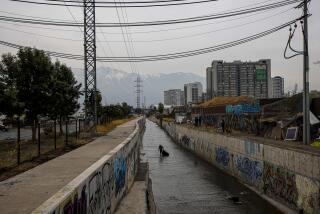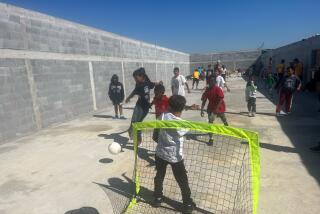Victims of Old Laws, War, Political Violence : Latin America Struggling to Aid Legions of Abandoned Children
SANTIAGO, Chile â Most Latin American countries are stepping up efforts to help millions of abandoned children. But they often are frustrated by critical economic conditions, old laws, war and political violence.
From Mexico to Chile, governments are allocating new resources, passing legislation and establishing aid institutions.
Nevertheless, the results remain poor.
Millions of children still live in the streets, eating what food they can get through begging, odd jobs or crime, including stealing and drug trafficking, authorities say.
But some successes have been reported.
Training Program
The government in the Brazilian state of Sao Paulo runs a special program to teach carpentry, mechanics and other trades to children picked in the streets. More than 9,000 children are being trained.
UNICEF, the United Nations Childrenâs Fund, has called the Sao Paulo program âunique, creative, modern,â and urges similar programs on other Latin American countries.
âOur aim is to provide alternative education and training programs that can help abandoned children and keep them away from the road that usually leads to crime,â said Alda Marco Antonio, secretary of the Sao Paulo Office for Children.
Leonardo, a boy who lived for years in the streets of Sao Paulo and often stole for a living, is now learning to be a carpenter.
Reluctant at First
âI used to steal, beg,â Leonardo told a visitor in Sao Paulo. He said he was once arrested in the street, and rather than go to jail reluctantly accepted a place in the government program.
âThat was the best decision in my life,â Leonardo said.
But Brazilian authorities estimate that 7 million children have been abandoned in their country of 143 million people. An additional 36 million children are listed as lacking housing, education and health services.
Brazil is not alone.
Although most governments do not have exact figures, some Mexican officials estimate that the number of abandoned children in their country may be as high as 12 million, almost as many as the 14 million attending the nationsâ schools.
âSituation of Riskâ
Similar situations prevail in other countries in the region.
In Peru, the government estimates that 45% of the nationâs children âlive in a situation of risk,â many of them totally abandoned.
Chile is widely credited with having one of the best aid programs in Latin America and has substantially reduced the number of abandoned children. The National Service for Minors says that Chileâs military government spends $208 million a year in assistance programs and that the number of street children has dwindled to a few hundred.
The program operates through private and church institutions. Even the militarized national police force is involved, offering 33 homes for the children.
Lottery, Gambling Tax
In Ecuador, the government recently levied a tax equivalent to 1 cent on all checkbooks issued by banks and a 2% tax on lottery tickets and other gambling to gather funds for child aid programs.
Luis Alfredo Cevallos, head of the Ecuadorean Childhood Institute, said the system was ârevolutionary in Latin America,â adding that the government expects to collect $7.7 million during the first year.
In many countries, juvenile crime has become a major problem, authorities say. This is especially true in Colombia, Brazil and Mexico.
In some Colombian cities, including Bogota, the capital, organized gangs of children, called galladas, are responsible for hundreds of crimes, according to the police.
Product of Injustice
The Rev. Javier de Nicolo, a Roman Catholic priest working with abandoned children in Bogota, says the problem is the result of âthe enormous poverty in an unjust society.â
The Colombian Institute for Family Welfare, a government agency, says it spends $100 million a year providing shelter, food and clothing for about 24,000 children. But officials say that figure represents only 20% of the children in need of help.
Officials in many countries say they often find that children living in the streets do not want to leave the freedom they believe they have and refuse to enter aid institutions.
âIn the street we have a âjobâ (stealing), and we can smoke marijuana,â said Marcelino, a street boy in Bogota. âAnd when we have problems with the cops, we âfix themâ by giving them some money or part of our loot.â
The government of Argentina has sent a bill to Congress to replace the only existing law to aid abandoned children, which has been in effect since 1919.
Teaching Center
The government has used $500,000 supplied by the United Nations to establish a center for teachers specialized in dealing with abandoned children.
The situation in Argentina âis manageable but is being worsened by the economic crisis,â said the governmentâs secretary for human development, Enrique de Vedia. He estimated that 7,000 children live in the streets in Argentina, while 3 million others live in extreme poverty.
Elsewhere in Latin America government officials also cite economic crisis as the biggest hurdle in aiding abandoned children. The crisis has been worsened in recent years by Latin Americaâs combined foreign debt of about $400 billion.
In the impoverished nations of Central America, the situation for children has been worsened by years of war and political violence. Thousands of children have been left orphans, abandoned or displaced.
51,000 Orphans
In Nicaragua, the Sandinista revolution and war with the U.S.-backed Contras have left 51,000 orphans, according to the government. Similar situations have occurred in El Salvador and Guatemala.
Nicaraguan officials claim that through a Cuban-backed massive education program, they have succeeded in bringing illiteracy down from 50% to 13%. But they add that the Contra-Sandinista conflict has forced the closing of 502 elementary and high schools.
âWe cannot implement our projects because of the war,â said Marcia Ramirez, head of the Nicaraguan Social Security Institute. âWe just donât have the money.â
More to Read
Sign up for Essential California
The most important California stories and recommendations in your inbox every morning.
You may occasionally receive promotional content from the Los Angeles Times.










